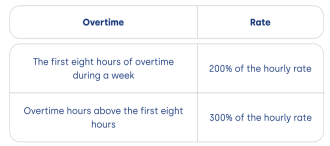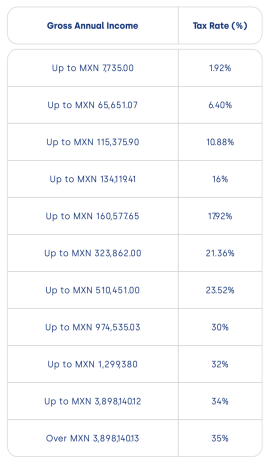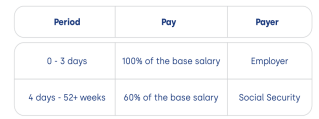每月最低工资
- 2025 年 1 月 1 日起,墨西哥的最低工资因通货膨胀调整上涨 12%,日工资从 248.93 墨西哥比索提高到 278.80 墨西哥比索;在北部边境免费区,最低工资从 374.89 墨西哥比索提高至 419.88 墨西哥比索。
- 圣诞奖金:服务年限至少为 1 年的员工有权获得 15 天的全额工资,而服务年限不足 1 年的员工将获得与其服务年限成比例的金额。
加班工资和最长工作时间
- 加班费是强制性的。超出最高工作时间的工作时间被视为加班,每周加班时间没有上限。对于额外的工作时间,员工将获得报酬。标准工作时间为每天 8 小时,每周最多 48 小时。如果每周工作时间为 40 小时,则标准工作时间为周一至周五。延长工作时间为周一至周六 48 小时。

个人所得税
- 个人所得税税率为 1.92% 至 35%。所得税按累进税率计算。

法定假期
工作年限与休假时间对应如下:
| 工作年限 | 休假时间 |
|---|---|
| 1 年 | 12 days |
| 2 年 | 14 days |
| 3 年 | 16 days |
| 4 年 | 18 days |
| 5 年 | 20 days |
| 每 5 年(5 年后) | 2 additional days |
法定假日
- 墨西哥庆祝七个国家节日和一个地方节日。

其他假期
- 产假:怀孕员工有权享受 84 天的带薪休假。休假必须在孩子出生前 40 天开始,并且不能间断。在此期间,员工将获得其平均工资的 100%,墨西哥社会保障局 (IMSS) 将负责支付这笔工资。员工还可以在产后六个月内申请休息,即哺乳期。员工可以延长假期,但不支付工资。
- 陪产假:雇员有权享受五天带薪陪产假。员工在此期间将获得其平均工资的 100%,雇主将负责支付这笔工资。
- 带薪病假:员工有权享受最多 52 周的带薪病假,并且墨西哥社会保障机构可能会给予额外周数,根据疾病类型,休假时间由不同支付者按不同费率支付。

劳动合同
- 1、合同必须是西班牙语,并且可以是双语的,由双方书写并签字;
- 2、不可以倒签;
- 3、合同内容需要包含:姓名,开始日期,雇佣期限,职位描述,薪酬和福利,终止条件,圣诞奖金。
- 备注:建议无固定期限
试用期
30 – 180 天
雇主成本
- Social Security lMSS – MXN 643.71
- LocalTax – 3.00% (各个州的情况略有调整,3 – 4%;各个企业享受的税收优惠政策不同,请注意核实)
- Surplus Fee(extra social security cost for special salaries) 1.10%
- Occupational risk – 0.50% (这只是风险最低的情况下。我们需要仔细审核公司的情况和员工的风险系数)
- Retirement and old age – 4.241%
- Retirement – 2.0%
- Benefit for disabilities – 0.70%
- Disablement and Life Insurance – 1.75%
- Nursery and Social Benefits – 1.0%
- Medical Expenses – 1.05%
- Infonavit(mortgage fund) – 5.0%
解雇(法律要求和最佳实践)
- 通知期:墨西哥没有通知期。
- 主动离职:无需赔付,允许员工通过提供签名的辞职信随时辞职,但是需要和员工结算未休的福利。
- 试用期内解雇:允许任何一方雇主在试用期内随时以员工不适合该职位为由解雇员工(在一般情况下,可能涉及赔偿)。在试用期内解雇员工需要双方签署解雇协议。
- 协商解雇:允许雇主和雇员双方同意以任何理由终止雇员的雇佣关系,需要支付遣散费。无故解雇时必须支付。遣散费为 3 个月工资,另加每服务一年 20 天工资,以及每年 12 天工资的工龄津贴。(这里需要添加一项,没有结算的各项津贴)
- 有理由解雇:解雇原因必须毫无疑问且无可争辩地得到证明。雇主必须向雇员提供一份书面文件(称为 Acta Administrativa),描述导致解雇的行为以及发生的日期。员工必须承认不当行为并签署文件,接受解雇。如果员工拒绝签署文件,雇主必须通过法院启动法律程序。未能证明解雇的合法理由被视为不公平解雇,可能对雇主会有民事诉讼及大额赔偿的影响。

发表回复